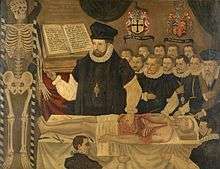John Banister (anatomist)


John Banister (1533–1610) was an English anatomist, surgeon and teacher. He published The Historie of Man, from the most approved Authorities in this Present Age in 1578.
Life
He began his professional life as surgeon to the forces sent under Ambrose Dudley, 3rd Earl of Warwick in 1563 to relieve Le Havre. On this expedition he and William Clowes, another surgical author, began a friendship which lasted throughout their lives. Some time after his return he studied at Oxford, and received a license to practise in 1573. For several years he practised both physic and surgery at Nottingham.
The military expedition to the Low Countries under Robert Dudley, 1st Earl of Leicester in 1585 gave Banister another opportunity of public service, and he served on board ship. After the expedition he settled in London, and in 1588 he and Clowes are associated in the dedication of John Read's Translation of Arceus. They saw many cases together, and in 1591 T. P., a patient of theirs, praised both surgeons in a bad English poem. Complaints were often made at that time to the College of Physicians as to surgeons practising medicine, and, perhaps in consequence of some such difficulty, Banister in 1593 obtained a royal letter of recommendation which led the college to grant him a license (15 February 1594) on the condition that in dangerous cases he should call in one of its fellows.
Banister was known for his kindness to the poor, especially to old soldiers, and for his extensive professional reading. He lived in Silver Street (Antidotarie), and was buried in the church of St. Olave in that street, since destroyed, with the record of his death, in the great fire. He had a long epitaph in English verse, which bears sufficient resemblance to some poems of Clowes to make it likely that it was written for Banister's tomb by his old friend.
Works
He edited Hans Jacob Wecker, with corrections, ‘A Compendious Chyrurgerie gathered and translated (especially) out of Wecker,’ London, 1585. He compiled a collection of remedies and prescriptions, ‘An Antidotarie Chyrurgicall,’ London, 1589, in which he acknowledges the generous help of his contemporaries, George Baker, Robert Balthrop, Clowes, and Goodrus. He also published in folio ‘The History of Man, sucked from the Sap of the most approved Anatomists, 9 books, London, 1578.’ Calametius, Tagaltius, and Wecker, three dry and unprofitable writers on surgery, form the basis of his writings. No cases from his own practice are given. In 1633, some time after Banister's death, a collected edition of his surgical works was published, ‘The Workes of that Famous Chyrurgian, Mr. John Banester,’ in six books.
See also
External links
| Wikimedia Commons has media related to John Banister (1533-1610). |
Acknowledgement
 This article incorporates text from a publication now in the public domain: "Banister, John (1540-1610)". Dictionary of National Biography. London: Smith, Elder & Co. 1885–1900.
This article incorporates text from a publication now in the public domain: "Banister, John (1540-1610)". Dictionary of National Biography. London: Smith, Elder & Co. 1885–1900.